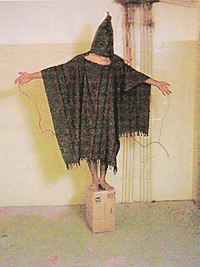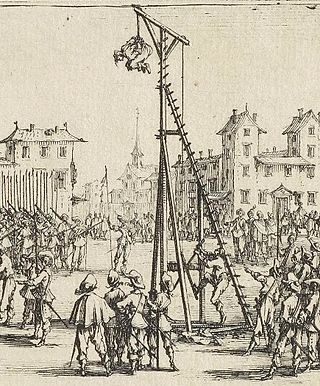
The strappado, also known as corda, is a form of torture in which the victim's hands are tied behind their back and the victim is suspended by a rope attached to the wrists, typically resulting in dislocated shoulders. Weights may be added to the body to intensify the effect and increase the pain. This kind of torture would generally not last more than an hour without rest, as it would otherwise likely result in death.
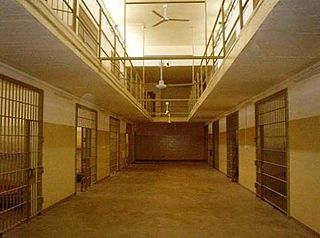
Abu Ghraib prison was a prison complex in Abu Ghraib, Iraq, located 32 kilometers (20 mi) west of Baghdad. Abu Ghraib prison was opened in the 1950s and served as a maximum-security prison. From the 1970s, the prison was used by Saddam Hussein to hold political prisoners and later the United States to hold Iraqi prisoners. It developed a reputation for torture and extrajudicial killing, and was closed in 2014.

During the early stages of the Iraq War, members of the United States Army and the Central Intelligence Agency committed a series of human rights violations and war crimes against detainees in the Abu Ghraib prison in Iraq. These abuses included physical abuse, sexual humiliation, physical and psychological torture, and rape, as well as the killing of Manadel al-Jamadi and the desecration of his body. The abuses came to public attention with the publication of photographs by CBS News in April 2004, causing shock and outrage and receiving widespread condemnation within the United States and internationally. The International Committee of the Red Cross reported that most detainees were civilians with no links to armed groups.
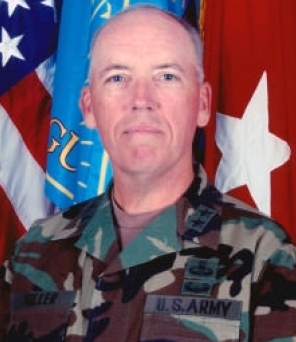
Geoffrey D. Miller is a retired United States Army major general who commanded the US detention facilities at Guantanamo Bay, Cuba, and Iraq. Detention facilities in Iraq under his command included Abu Ghraib prison, Camp Cropper, and Camp Bucca. He is noted for having trained soldiers in using torture, or "enhanced interrogation techniques" in US euphemism, and for carrying out the "First Special Interrogation Plan," signed by the Secretary of Defense, against a Guantanamo detainee.
This article describes the use of torture since the adoption of the 1948 Universal Declaration of Human Rights (UDHR), which prohibited it. Torture is prohibited by international law and is illegal in most countries. However, it is still used by many governments.
Ghost detainee is a term used in the executive branch of the United States government to designate a person held in a detention center, whose identity has been hidden by keeping them unregistered and therefore anonymous. Such uses arose as the Bush administration initiated the War on Terror following the 9/11 attacks of 2001 in the United States. As documented in the 2004 Taguba Report, it was used in the same manner by United States officials and contractors of the Joint Interrogation and Debriefing Center at the Abu Ghraib prison in Iraq in 2003–2004.
Far' Falastine, also known as Branch 235, is a prison operated by Syrian Intelligence under the charge of Brig. Gen. Kamal Hassan between 2017 and 2020, located in Damascus, notorious for accounts of torture, coercive interrogation, and deplorable conditions related by its former detainees.
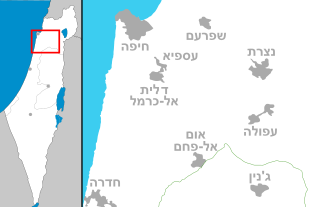
Camp 1391, also referred to as Unit 1391 or Facility 1391, is an Israel Defense Forces prison camp in northern Israel for "high-risk" prisoners. It is run by Unit 504. The existence of the prison was unknown to the public before 2003, and most information about it remains classified, although the Supreme Court of Israel ordered the release of some information about the jail.
There are cases, both documented and alleged, that involve the usage of torture by members of the United States government, military, law enforcement agencies, intelligence agencies, health care services, and other public organizations both in and out of the country.
"Enhanced interrogation techniques" or "enhanced interrogation" was a program of systematic torture of detainees by the Central Intelligence Agency (CIA), the Defense Intelligence Agency (DIA) and various components of the U.S. Armed Forces at remote sites around the world—including Bagram, Guantanamo Bay, Abu Ghraib, and Bucharest—authorized by officials of the George W. Bush administration. Methods used included beating, binding in contorted stress positions, hooding, subjection to deafening noise, sleep disruption, sleep deprivation to the point of hallucination, deprivation of food, drink, and medical care for wounds, as well as waterboarding, walling, sexual humiliation, rape, sexual assault, subjection to extreme heat or extreme cold, and confinement in small coffin-like boxes. A Guantanamo inmate's drawings of some of these tortures, to which he himself was subjected, were published in The New York Times. Some of these techniques fall under the category known as "white room torture". Several detainees endured medically unnecessary "rectal rehydration", "rectal fluid resuscitation", and "rectal feeding". In addition to brutalizing detainees, there were threats to their families such as threats to harm children, and threats to sexually abuse or to cut the throat of detainees' mothers.
The future of Palestinian prisoners detained by Israel in the context of the Israeli–Palestinian conflict is considered central to progress in the Israeli–Palestinian peace process. Cases of prison sentences include the charges of terrorism or being a member of an "illegal terrorist organization", such as Hamas or prior to the Oslo Accords the Palestine Liberation Organization, but according to some accounts also by political activism such as raising a Palestinian flag.
The Public Committee Against Torture in Israel is an Israeli NGO established in 1990 that monitors the use of torture and ill-treatment by Israeli security services against Palestinians under detention. PCATI was founded in 1990 in reaction to what it describes as "the ongoing policy of the Israeli government, which permitted the systematic use of torture and ill treatment in Shin Bet interrogations".
The widespread and systematic use of torture in Turkey goes back to the Ottoman Empire. After the foundation of the Republic of Turkey, torture of civilians by the Turkish Armed Forces and Turkish police was widespread during the Dersim rebellion. The Sansaryan Han police headquarters and Harbiye Military Prison in Istanbul became known for torture in the 1940s. Amnesty International (AI) first documented Turkish torture after the 1971 Turkish coup d'é

The Landau Commission was a three-man Commission set up by the Israeli Government in 1987 following a long-running scandal over the deaths of two Palestinian prisoners in custody and the wrongful conviction of a Circassian IDF officer. The Commission, headed by former Supreme Court Justice Moshe Landau, found that the GSS interrogators routinely used physical force during the interrogation of prisoners and then committed perjury at subsequent trials. In its conclusion, approved by Cabinet in November 1987, it lay down guidelines for the use of a "moderate measure of physical pressure". The details of the recommended methods were described in the classified appendix to the report. In 1994 the UN Committee Against Torture stated: "The Landau Commission Report, permitting as it does 'moderate physical pressure' as a lawful mode of interrogation, is completely unacceptable to this Committee."
The Al-Moskobiya, Moscobiyeh, Muscovite or Moscovia Detention Centre is an Israeli detention and interrogation facility and prison in the Russian Compound of West Jerusalem. The center is used to interrogate Palestinian detainees and prisoners from a variety of age groups, including children. The Palestinian NGO Addameer has alleged that harsh methods of torture are used there.
Israeli torture in the occupied territories refers to the use of torture and systematic degrading practices on Palestinians detained by Israeli forces in both the West Bank and Gaza Strip. The practice, routine for decades, was eventually reviewed by the Supreme Court of Israel in 1999, which found that "coercive interrogation" of Palestinians had been widespread, and deemed it unlawful, though permissible in certain cases. Torture is also practiced by the Palestinian authorities in the West Bank and the Gaza Strip.

Since the outbreak of the Israel–Hamas war on October 7, 2023, Israel has carried out mass arrests and detentions of Palestinians. Thousands have been arrested in the Israeli-occupied Palestinian territories and in Israel, based on alleged militant activity, offensive social media postings, or arbitrarily.
During the 2023–24 Israel–Hamas war, Israeli male and female soldiers, guards as well as medical staff have reportedly committed wartime sexual violence against Palestinians children, women and men; including rape, gang-rape, sexualized torture and mutilation. In February UN experts cited at least two cases of Palestinian women being raped by male Israeli soldiers. Palestinian boys and men have also been raped and subjected to torture, and in some cases the torture has led to the victim's death.

During the Israel–Hamas war, Israel has systematically tortured Palestinians detained in its prison system. This torture has been reported by the United Nations, Human Rights Watch, Amnesty International, as well as Israeli nonprofit human rights organizations such as Physicians for Human Rights Israel and B'Tselem.

Sde Teiman is an Israeli military base located in the Negev desert near the border with the Gaza Strip. During the Israel–Hamas war, its use as a detention camp doubled and gained international attention for its systemic human rights violations against its Palestinian detainees from the strip.
